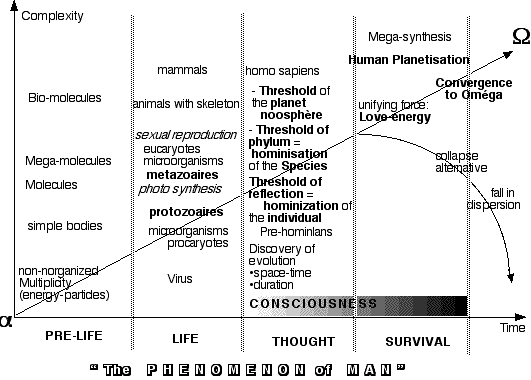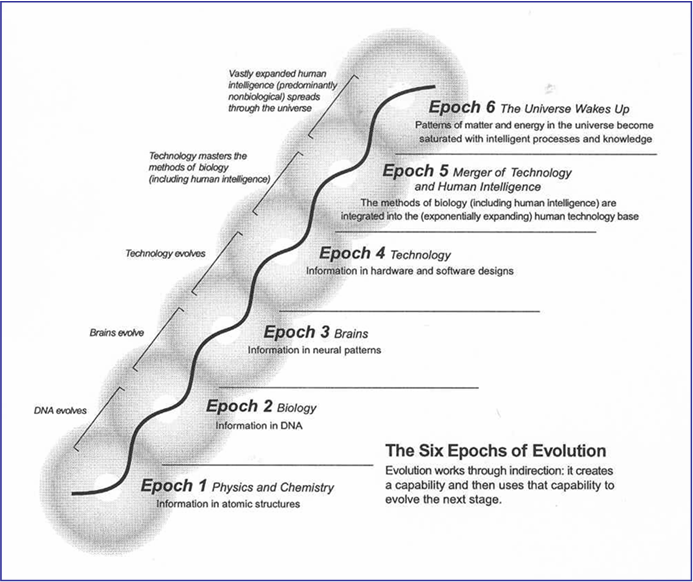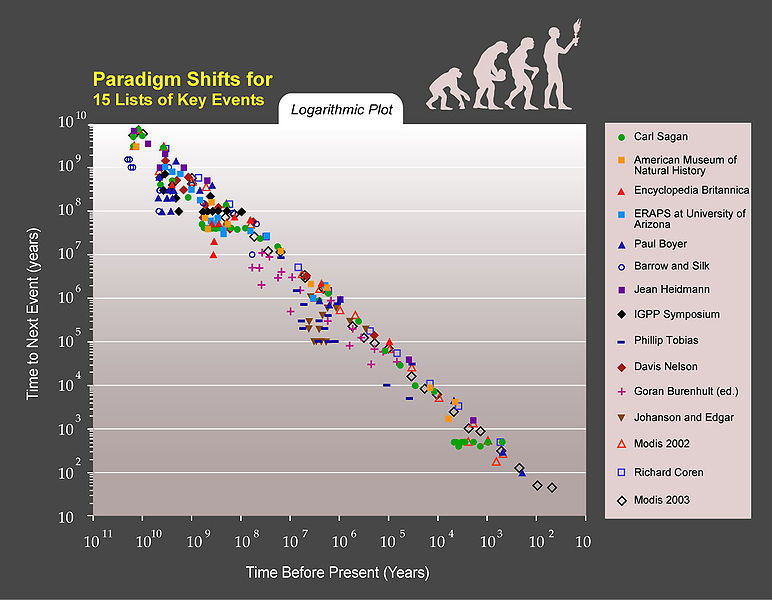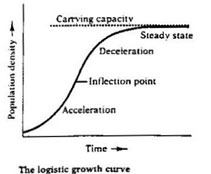
Clarity - Heart of the Sun, from Love in the Time of Posthumans, An Open Source Screenplay, Creative Commons licence
| Singularity (Posthuman transcension) | ||
| Singularity (Posthuman transcension) | Singularity (Posthuman transcension) |
| Cosmic Evolution | |||
| Unit Timescale Back: History | Unit Evolution Back: Mind | Unit Timescale: Future | Science |
 Clarity - Heart of the Sun, from Love in the Time of Posthumans, An Open Source Screenplay, Creative Commons licence |
In mathematics, a singularity is a point at which a given mathematical object is not defined or not well-behaved, for example infinite or not differentiable. In the natural sciences, a point in spacetime where the laws of physics break down, for example where gravitational forces cause matter to have an infinite density and zero volume (as in a Black Hole). In transhumanism and futurism, the end of history as we know it, the point (Technological singularity) at which accelerating change and technological progress becomes so rapid, or alternatively that an exponential growth of artificial intelligence surpasses human levels of intelligence, so that it becomes impossible to predict the nature of any post-singularity intelligence or technological civilization; see Acceleration Watch website for more. Teilhard de Chardin's Omega Point and Sri Aurobindo's Supramental transformation are metaphysical equivalents. The following provides a short and no doubt incomplete potted history of the theme of evolution and transcendence. MAK110419
German Idealism: a movement in philosophy, started with Immanuel Kant's transcendental idealism, centered in Germany. Many prominent exponents include Georg Wilhelm Friedrich Hegel, Johann Gottlieb Fichte and Friedrich Wilhelm Joseph Schelling. See also Naturphilosophie. A prequel to Darwinian evolution. (Wikipedia glossary)
In the 19th century, universal histories proliferated. Philosophers such as Kant, Schiller and Hegel, and political philosophers such as Marx, presented general theories of history that shared essential characteristics with the Biblical account: they conceived of history as a coherent whole, governed by certain basic characteristics or immutable principles. For example, Hegel presented the idea that progress in history is actually the progress not of humankind's material existence, but of humanity's spiritual development. Concomitantly, Hegel presented a developmental theory of how the human spirit progresses: through the dialectic of synthesis and antithesis. Marx's theory of dialectic materialism is essential to his general concept of history: that the struggle to dominate the means of production governs all historical development. (Wikipedia)
Russian cosmism: philosophical and cultural movement that developed in Russia in the late 19th and early 20th century. It entailed a broad theory of natural philosophy combining elements of religion and ethics with a history and philosophy of the origin, evolution and future existence of the cosmos and humankind (including advanced technology and space exploration). Incorporated many ideas that would later be adapted by transhumanism. (MAK, Wikipedia)
Sri Aurobindo: (1872-1950) Indian evolutionary philosopher, yogi, and poet, who worked for freedom from British rule before giving up politics and developing his own vision of human progress and spiritual evolution. Together with his co-worker the French mystic Mirra Alfassa he taught the evolution of consciousness culminating in the emergence of a future supramental species and transformation of the world (in this context, the technological singularity is a naturalist equivalent). His ideas have some intriguing parallels with those of Teilhard de Chardin, and he integrated evolutionary thinking with Eastern philosophy the way Teilhard synthesised evolution with Christianity. Neither rejected Darwinism, although in contrast to theistic evolution, both understood evolution panentheistically as the emergence of the Divine out of matter (rather than separate from and above matter). MAK110419
Vladimir Ivanovich Vernadsky: (1863-1945) Ukrainian interdisciplinary scientist; the father of Russian ecology. He helped establish the fields of geochemistry, biogeochemistry, and of radiogeology. His ideas of noosphere were an important contribution to Russian cosmism. His 1926 book The Biosphere developed Eduard Suess' earlier 1885 concept of the biosphere into the idea of life as a geological force, similar to James Lovelock's Gaia theory. This is very different to the watered down biosphere of popular thought which is nothing but a mere envelope clinging to the surface of the planet (Teilhard also seems to describe the biosphere in this way, as an envelope). He also developed the idea of the noosphere, which he interpreted as the third stage in the earth's development, mind as a geological force; here we see obvious parallels with transhumanism. Vernadsky influenced Teilhard de Chardin and no doubt vice-versa, when they met in Paris when he Vernadsky was lecturing at the Sorbonne in Paris, although Vernadsky's theory of Earth evolution was purely materialistic, in contrast to Teilhard's Panentheism. (MAK, Wikipedia)
 Teilhard de Chardin's cosmology. The evolution of consciousness and matter is shown as a diagonal line proceeding from lower left to upper right. Image: Scheme of The Phenomenon of Man, graphic by J.S. Abbatucci, from Teilhard de Chardin Phenomenon of Man (important extracts of the book). |
Teilhard de Chardin, Pierre: (1881-1955) French philosopher and Jesuit priest who trained as a paleontologist and geologist and took part in the discovery of both Piltdown Man and Peking Man. Teilhard conceived the idea of the Omega Point and developed the concept of Noosphere. He came into conflict with the Catholic Church, and several of his books were censured. His primary work The Phenomenon of Man, set forth a sweeping account of the unfolding of the cosmos. He saw no contradiction between Darwinism and Theism, rejected traditional interpretations of a supernatural creator and creation in the Book of Genesis in favor of a panentheistic teleology. Teilhard envisaged the "within" (consciousness) and the "without" (matter) as complementary, each subject to its own evolutionary principle, which he called radial and tangential energy respectively. The former corresponds to the ascent of consciousness and evolution to divinity, the latter to evolution as described by Darwinian science. To this day, Teilhard remains one of the very few individuals whose work seamlessly integrates both evolutionary science and theistic religion, not in a dualistic supernatural context of theistic evolution, but in a holistic and pantheistic manner.
Although the two never met, and neither knew of the other's work, Teilhard's ideas have some intriguing parallels with those of Sri Aurobindo (although in terms of W.C. Snow's "Two Cultures", Teilhard arrives at spirituality from the perspective of the sciences, Aurobindo from the humanities). His ideas are also very similar to those of A. N. Whitehead, both beings strongly influenced by Henri Bergson. Seems to have been one of the very few who integrated the "Two Cultures". Teilhard's cosmology, but not his strict anthropocentrism, have been strongly influential in the New Age movement, Transhumanism, the Universe Story, Integral Theory, and other contemporary advocates of evolution of consciousness, while his term complexification has been adopted by contemporary systems science.
Omega point: in Teilhard de Chardin's pantheistic evolutionary theology, the personal and transcendent state of maximum complexification, towards which the Earth is evolving, and associated or identified with Christ; the end of history, or of history as we know it. Enormously influential (generally second or third hand) on the new age movement. Similar to Sri Aurobindo's independently arrived at but more radical concept of Supramental transformation, and the Transhumanist Singularity (perhaps direct or indirect influence re the history of ideas). The mathematical physicist and cosmologist Frank J. Tipler developed a materialistic "hard science" version of Teilhard's Omega Point.
Teilhard's work has been strongly criticised by Stephen Jay Gould. For Teilhard, evolution tends to greater complexity and consciousness; for Gould, there is no such thing as ascent or progress, only random natural selection. While Teilhard's strong teleological approach is anathema to mainstream naturalist science (with a few exceptions such as Conway Morris) Gould's equally extreme but diametrically opposite blanket denial that evolution results in the emergence of greater complexity hasn't fared much better; as well as being contrary to the findings of systems theory it is mostly also rejected even by other evolutionists. MAK110419
Transhumanism is emergent philosophy analysing or favouring the use of science and technology, especially neurotechnology, biotechnology, and nanotechnology, to overcome human limitations and improve the human condition. Dr. Robin Hanson describes it as "the idea that new technologies are likely to change the world so much in the next century or two that our descendants will in many ways no longer be 'human'." See also conscious evolution, singularity.(Wikipedia glossary)
Influences, precursors, and early developments can be found in the philosophy of Nietzche (the Superman who surpasses the current human species), the Russian Cosmism of Nikolai Fyodorov, the cosmology of Teilhard de Chardin, geneticist J.B.S. Haldane's 1923 essay Daedalus: Science and the Future, which predicted that great benefits would come from applications of advanced sciences to human biology, speculations on space colonization, bionic implants, and cognitive enhancement by J. D. Bernal, futurologist FM-2030, who taught "new concepts of the Human" at The New School of New York City in the 1960s, computer scientist Marvin Minsky, who wrote on relationships between human and artificial intelligence beginning in the 1960s, the Alcor Life Extension Foundation of California, which froze recently deceased subscribers in the 1980s in the hope they would be revived by a future ultra-tech civilization, and the work of Eric Drexler, who in 1986 published Engines of Creation: The Coming Era of Nanotechnology, which discussed the prospects for nanotechnology and molecular assemblers, and founded the Foresight Institute. In the late 1980s Max More and Tom Morrow (such eccentric names are not unusual here!) created his own particular transhumanist doctrine, called Extropianism and laid the foundation of modern transhumanism. Since then, many other forms of Transhumanism have emerged, including Posthumanism, Postgenderism, Singularitarianism, Technogaianism, Buddhist and Christian Transhumanism, and more. (From Wikipedia)
 Cosmic Evolution diagram by Ray Kurzweil (Kurzweil 2005). The technological singularity ("human-machine convergence,") occurs at the intersection of Epoch 4 and Epoch 5. (book review and description). Compare this diagram with J.S. Abbatucci's representation of Teilhardian cosmology. |
Integral to transhumanism is the idea of the Technological singularity, which refers to the postulated near-future emergence of greater-than human intelligence. The term was coined by mathematician and science fiction writer Vernor Vinge, who argues that artificial intelligence, human biological enhancement or brain-computer interfaces could be possible causes for the singularity. Since the capabilities of such an intelligence would be difficult for an unaided human mind to comprehend, the occurrence of technological singularity is seen as an intellectual event horizon, beyond which the future becomes difficult to understand or predict. Nevertheless, proponents of the singularity typically anticipate such an event to precede an "intelligence explosion", wherein superintelligences design successive generations of increasingly powerful minds. The concept is popularized by futurists like Ray Kurzweil and widely expected by proponents to occur in the early to mid twenty first century. (From Wikipedia)
 Major paradigm shifts in the history of the world, as seen by fifteen different lists of key events. When plotted on a logarithmic graph, 15 separate lists of key events in cosmic, biological, and human history show an exponential trend. There is a clear trend of smooth acceleration through biological evolution and then technological evolution. Lists prepared among others by Carl Sagan, Paul D. Boyer, Encyclopedia Britannica, American Museum of Natural History and University of Arizona, compiled by Ray Kurzweil. This graph is based on data compiled by Theodore Modis, who "attempted to develop a precise mathematical law that governs the evolution of change and complexity in the Universe" (see e.g. Modis 2002; note that Modis is critical of Kurzweil's predictions (Modis 2006). Note also the "March of Progress" icon at top right. References: Kurzweil 2005 Graph appears on p.19, description is p.18-20 plus notes on p.501-502. (From Wikipedia (including further references)) |

Of course, it could be argued that in describing accelerating change, the transhumanists haven't taken into account the sigmoid shape of the logistic growth curve, as shown on the right (diagram from John Wilkins' Evolving Thoughts blog). However if the growth curve does indeed go all the way back to the Big Bang, I find it unlikely that after thirteen billion years it the curve would just coincidentally flatten out in the next few decades. A stronger objection is that these sort of exponential cosmic growth curves are simply an artifact of logarithmic time; the closer to the present an event is, the more we know of it, and hence the more information (and record of change) there is. However, even if this is the case, this still does not negate the fact that the cosmos seems to organise itself in progressively more complex configurations of matter and consciousness, as observed by Teilhard, Erich Jantsch, and others. MAK111014
The value of Transhumanism, Singularitanism, and other such speculations is that they point to a possible future direction that post-biological and post-human evolution might take, a new kingdom of life or threshold of increasable complexity. Such speculations are a popular element in contemporary science fiction, especially "hard science" writers such as Greg Egan, Alastair Reynolds, and Charles Stross. Interestingly, these themes tie in with early twentieth century visionary metaphysical ideas such as the Omega Point of Teilhard de Chardin and the Supramental transformation of Sri Aurobindo. If 13.7 billion years of cosmic evolution have brought us this far, this is a possible and very optimistic glimpse of the future. Of course, the human experiment might just as likely end with a whimper or a bang in an anthropogenic sixth extinction. (MAK110716)
| Home |
page MAK110419, MAK111014, edited RFVS111203